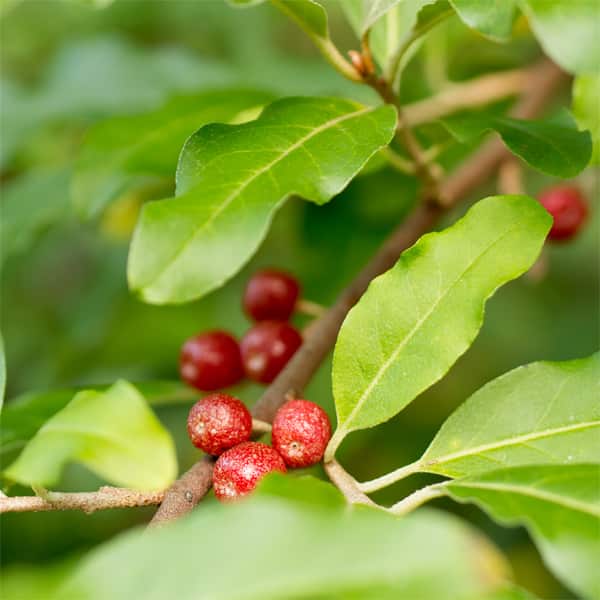
Chances are you’re noticing this ubiquitous shrub this fall along roadways, at the edge of the woods and perhaps even in your own yard. Heavy clusters of red, pea-size berries bunch-up along each branch, contrasting attractively with the silvery-green foliage. Its green berries form in early summer, turning red as cooler nights arrive and persist on the bush until they drop weeks later or are taken by birds. Few plants produce fruit so profusely as the autumn olive (Elaeagnus umbellata): a single mature plant can produce 25 or more lbs. of berries every year!
Originally introduced to the USA from Asia in the 1830’s, for many decades autumn olive seemed to be well behaved. It excels as a species that grows in sunny areas where few other plants can survive, improves barren soil fertility, stabilizes steep slopes, forms windbreaks in desolate regions and produces fragrant flowers, cover and edible fruit for wildlife. In 1963 the heavy-fruiting cultivar ‘Cardinal’ was selected by the USDA, and soon thereafter it began multiplying explosively. Its seedlings quickly dominated major open-field areas, began out-competing native plants; it is now considered one of the toughest invasive invaders in much of the eastern USA and into Canada.
In a single season autumn olive can grow 6 ft. or more, maturing as a spiny-branched multi-stem shrub in only a few years at 15 ft. or more high and wide. Its green leaves are 2-3” long with wavy edges, showing their silvery undersides when the wind blows. Sweetly-scented ivory-colored flowers perfume the air in early June. Because its roots produce nodules that convert nitrogen from the air into a form usable by plants, it thrives in even the poorest and driest soils, rapidly forming nasty, impenetrable thickets that deer avoid browsing.
Controlling autumn olive is challenging because of the fecundity of its seed and its knack of aggressively re-sprouting from cut stems. Spring-germinated seedlings can reach 3 ft. or more by fall, often producing fruit even as year-old plants. Younger seedlings are relatively easy to pull out by hand. Older plants have shallow roots, and any broken-off when pulled can grow into new plants.
Interestingly, its copious, attractive, astringently-flavored fruit is extremely high in carotenoids, especially lycopene (17x more than tomato!), Vitamins A, C and E; for generations many Asians have relied upon the plentiful berries as a valuable resource to make flavorful juice and preserves.
If autumn olive appears in your yard, try to remove it before it establishes and starts seeding-in. You’ll need to be diligent, surveying your garden every year to identify and dig-out young seedlings before they become established and more difficult to remove (but still worth the effort!). Heavier infestations can be treated with herbicides, but the vigor of the species often renders those results ineffective.
Some have suggested (tongue-in-cheek, perhaps) that we emulate Eastern traditions and employ a defensive action to “reduce” the seed population–try picking the berries and processing them into your own homemade “Invasive Preserves”!
About the Author
Wayne Mezitt is a 3rd generation nurseryman, a Massachusetts Certified Horticulturist, now chairman of Weston Nurseries of Hopkinton, Chelmsford & Hingham MA, and owner of “Hort-Sense”, a horticultural advisory business. He currently serves in various capacities on several horticulturally-related organizations, including the Massachusetts Horticultural Society at The Gardens at Elm Bank in Wellesley MA, and chairman for the Massachusetts Invasive Plant Advisory Group (MIPAG).







